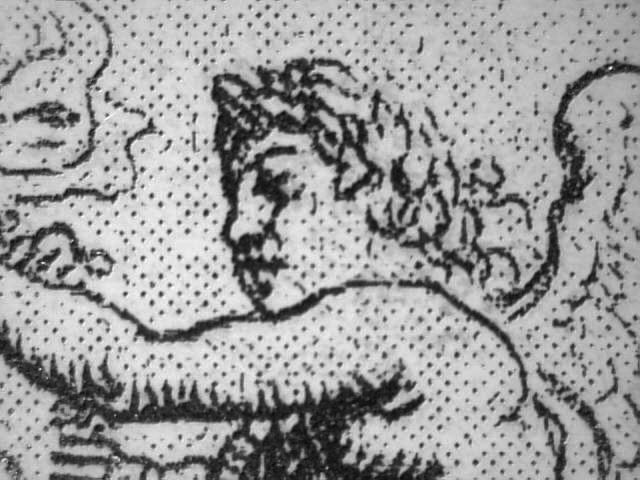
- •1. History and philosophy of prepress
- •1.1 Graphic industry
- •1.3 Stages of prepress development
- •1.3.1 Evolution of plate making
- •From manual to photo engraving
- •1.3.3 Electronic prepress
- •1.3.3.1 Remote publication and reproduction
- •1.3.3.2 Softproof
- •1.3.3.3 Image scaling
- •1.3.3.3. Halftoning
- •1.3.4 Computer aided prepress
From manual to photo engraving
There isn’t possible to govern tone level in litho and relief printing by varying the thickness of an ink layer. To reproduce the brightness of an original such printing systems operate in bi-level fashion: ink – no ink. That’s why they create on a print the illusion of grey level by the tiny discrete printed and blank elements which are continuously percept by a viewer. Ink amount and image appearance as dark, grey or light are regulated by varying such elements area.
So, during over three centuries the camera based plate making was preceded by manual engraving. The printing plates were made on a wood and later on other kind of materials including a metal. Printing relief was produced on the latter also by a chemical etching but the artist should, nevertheless, to engrave an image on the layer protecting such plate surface.
Photoengraving for continuous tone original has started to be widely used after about 50 years of photography invention when the method of autotypie (halftoning, screening) was found. The original was projected onto a sensitive photo layer through the so called projection screen - mesh of parallel or crossed lines. It has resulted in producing the transparency (photoplate) comprised of lines or dots of variable width. Since that time the artistic, time consuming skills of engraver weren’t any more required to, for example, urgently place the actual photo in the newspaper morning issue.
The quality levels for engraved and screened illustrative prints stay disputable until now (Figure 1.6) and, in spite of that, the use of photoengraved halftones had greatly arisen the pictorial matter amount in all kind of editions making them more informative as far as “the picture worth’s a thousand words”.


Figure 1.6. Distortion of an image fine details and contours by the halftone dots is evident from comparison the enlarged fragments of engraved (left) and screened (right) prints.
Each of listed above following stages look disruptive in relation to the previous one. At the same time, there can be noticed the smooth, evolutionary perfection within their periods. For photoengraving prepress it was, first of all, revealed in development of color separation and color correcting masking techniques, use of contact screens as well as in improving the properties of films therein applied.
Photographic method couldn’t initially provide the desired copying properties of halftone transparencies due to low (3 – 4 units) film contrast factor. That’s why such first image was duplicated for several times on the same kind of a film to get the “harder” halftone dots thereon.
Situation has radically changed with the super contrast “Lith” films development. Having the contrast of 10 -20 units they worked in binary, b/w fashion which in the best way corresponds to the basic condition of providing the screening (halftoning) effect.
The latest prepress cameras (Figure1.6) were the highly automated units with a microprocessor control of an image color separated capturing, exposure and film processing.

Figure1.6 Horizontal (a) and vertical (b) reproduction prepress cameras.
Along with moving forces and positive results of coming to the further step of development it isn’t out of place to put attention to certain losses involved by such transition. It sometimes happens in technical progress to sacrifice some specific feature of previous manual craft on behalf of advantageous indices of novel technique concerning, for example, the productivity increase, costs lowering or the like. The certain positive property of an old technology may for rather long time stay not realized within a new one.
Such situation took, in particular, place with printed picture sharpness and definition after invention of screening. It was used in engraving to cut the continuous thin line on a plate to show, for example, a fishing rod. Nevertheless, the halftone dots inherent in screening until now badly damage such fine details and contours of an image as was illustrated in figure 1.4. The number of original elements which can be separately presented per unit length of a halftone copy is ten times fewer of the printing process resolution. So, the integral quality of modern halftones stays inferior to that of some prints produced in the middle of XIX century from manually engraved plates. Quality of illustrations which were printed at the end of last century in short runs by the collotype method stays superior, as well, due to the tiny dots and blanks belonging to microscopic colloid structure of a plate. Electronic (nowadays “digital”) halftoning which would be capable to imitate the engraver skills at the level of artificial intellect and allowing for the same effective use of printing process facilities haven’t yet found wide practical implementation.
Such compromises can be looked over within each of above mentioned technology replacements. Some of initial problems could be thereafter gradually solved while the other ones were, to the contrary, redoubled at transition to the further technique generation.
